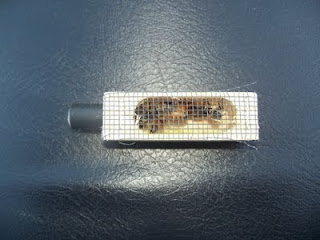On Friday, as soon as I got home and changed, we headed out to Bee Hill. Our goal: before the sun sets, find and kill the ineffective queen in Hive 3 and replace her with one of Harry Fulton's Russian queens. (For some information on Russian bees vs. Italians, read this interesting
article from North Carolina Cooperative Extension Service.)
Hot Friday Night Date: Murder!
Mark opened the bottom hive to an amazing sight. In moving the super, he tore open a queen cell the bees had created, and a brand new, fully formed queen emerged. Crazy. What are the chances? She was mobbed by worker bees, Mark rescued her with his hive tool, and we were caught in a pickle. We had nothing to put her in, no place for a virgin queen, and clearly the hive was going to kill her. So Mark did the only thing we knew to do . . . smash her.
 |
| One of the queen cells we inadvertently opened. |
As he moved the frames to look for the old queen, he dislodged a second "peanut" or queen cell . . . and another queen emerged, and she quickly ran away into the crowd of worker bees. With a $20 Russian queen ready to be installed, we had no choice but to track her down and kill this virgin queen too.
We combed through the remaining frames on both supers without any luck, and finally found a third queen hanging out on the frame holder right in front of Mark. She met the same fate as her rivals.
Triple homicide. Let's hope they take to the Russian queen.
 |
| The Russian queen is tended by 4 worker bees. |
What we learned from this experience is that if you suspect the bees need a new queen, they probably do too. They used some of the viable eggs their old queen laid to create several queen cells, and in time would have re-queened themselves. With the new Russian queen, in theory, she's already mated and proven to be an egg-layer, so once she's set free from her cage, she'll get right to work.










